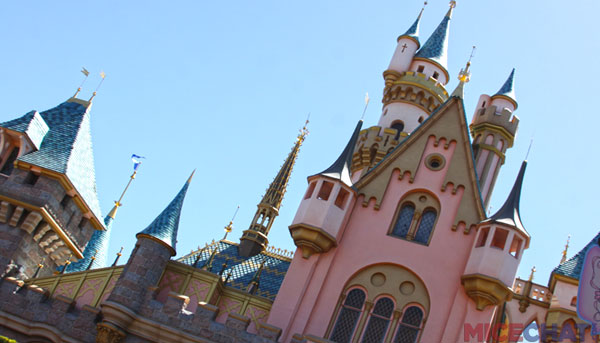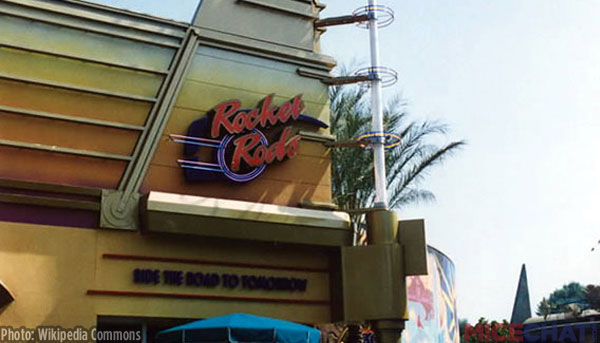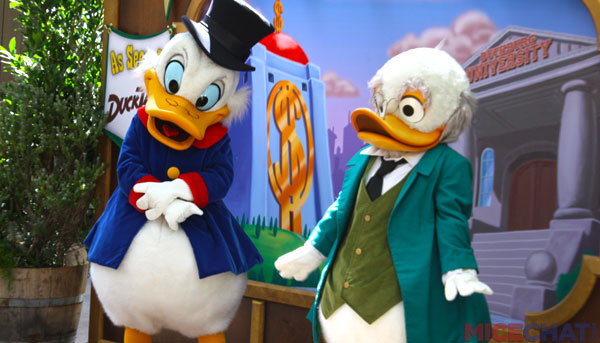Hello again MiceChat! First of all, thank you all for the many kind words left in the comments! I was overwhelmed by the response to my first article. While I had assumed that the pictures of the Rocket Rod destruction would be popular, I had no idea the level of interest was so high in the decision making processes behind the magic. Before I jump into a new topic, I thought I’d circle back and touch on a few outstanding questions and topics that were left in the comments of the last article.
.
.
Career Path: It wasn’t necessarily clear in the article, but I am no longer employed by the Walt Disney company. I had a great run but many reasons led me away to other endeavors. I won’t go into the personal side of the decision, but from a professional perspective I saw change coming to Disneyland that didn’t align with my interests. While I was at Disneyland, it was a relatively self contained operation. We reported up through the larger Parks & Resorts organization but for the most part TDA had everything you would need to run a standalone Resort. The current OneDisney initiative meant a combining of the Orlando and Anaheim operations resulting in a very different Team Disney Anaheim.
.
Take, for example, what was previously known as Foods Finance. During my tenure this group owned the financial planning for all aspects of the Foods operations. From managing the revenue “per caps” (Foods revenue divided by attendance) down to labor expenses. In today’s TDA, that function is pretty much centralized in Orlando. While on paper one can understand the leverage and efficiencies this can drive, it has unfortunately resulted in a situation where all Finance careers run through Orlando. I’ve always loved to vacation in WDW, but for me personally it definitely fell into the “nice place to visit but wouldn’t want to live there” category (again, purely for personal reasons). This simple fact has definitely limited any regret I had leaving Disneyland.
.
Lastly, on the career topic, many of you commented that you are studying Finance and would love to get on this career path. I encourage you to follow your dreams but one challenge I fear many will face is the severe lack of true entry-level Finance jobs at Parks & Resorts. The vast majority of roles require previous work experience (the luxury of an in-demand employer). As much as I’d like to say that working in the parks was the enabler for me to make the jump to Finance, I fear the two were mutually exclusive. I’m not saying this to discourage our young readers, I just wanted to let them know that I don’t really have an entry-level roadmap to follow. As anyone can tell you, ANY successful career will involve some lucky breaks and a healthy dose of “who you know.” That holds true in my story as well.
.
.
Rocket Rods: I said in my article that the Rocket Rods can really get Disneyland fans worked up, and that certainly came through in the comments! A few people asked about the genesis of the ride’s creation, but that decision pre-dated my employment at Disneyland. There were a few comments about how the scrapping of the vehicles was a mistake. This is one of those things where my passion for Disney and the “right” thing to do were definitely in conflict. I’d be the first to volunteer to preserve an old Rocket Rod vehicle…what a great piece of Disney history! But the realities of the situation led to the pictures I shared. From a financial perspective, there was a need to write off the outstanding balance of the investment. Unlike an old Toad ride vehicle, the Rocket Rods were still a depreciating asset on the books. The cleanest way to get them off the books was to destroy them and take the write off. Secondly, and perhaps more importantly, I can’t imagine a situation where there is upside for the company to keep them around or sell them off. Due to the highly specialized nature of the vehicles, there was really no chance of reusing any significant piece of the vehicles. Plus, it was a piece of history that everyone wanted to forget. Disney would never reuse them on display or as a prop (just brings up bad memories) and if they were sold to collectors, one could only imagine the negatively-slanted uses that could surface (I can already envision the YouTube video of people sitting in a vehicle talking about how the ride broke down again…years later)!
.
.
More Details: A few people asked for some more specific details…for example, how much was written off the books when Rocket Rods failed. While I’m hoping my articles will be insightful and provide context, specific numbers will be scarce. Besides the years that have passed which cause me to only remember approximations, I don’t feel comfortable sharing certain specific details.
.
OK…time for the next topic! I don’t have a really cool wheel to spin like our friend Bob Gurr, but let’s pick another topic out of the Rocket Rod scrap heap and move forward!
.
I’m going to jump back to one of my early projects in Finance. The Revenue Management group at Disneyland was the team tasked with managing the pricing and offers for both the admission tickets and hotels. If you bought a ticket or rent a room at Disneyland, this team determined how much you paid.
.
Defining “Child” at Disneyland
.
In early 2000 there was a disconnect at the domestic parks in what was considered a “child.” At the Disneyland ticket booths, a child ticket was for an individual aged 3 through 12. Walt Disney World had recently re-defined a child as ages 3 through 9. At the food locations throughout Disneyland, it mostly mirrored the 3 to 12 age, but there were a few inconsistencies. The question presented to the team was whether the domestic parks should standardize at 3 to 9.
.
As I mentioned, the Revenue Management team owned this analysis. So while one could argue about what was right for a restaurant’s kids meal, the decision was being driven by the ticket booths with the agreement that foods would follow.
.
Over my years in Finance, I can say this was one of the few analysis I performed where the “competitors” in the marketplace were a major input to the decision. For the most part, decisions at Disneyland were made in context of what was best for Disneyland… not caring too much about the moves that Knott’s, Universal, Busch, or Six Flags were making. This was a luxury of being a market leader. That’s not to say we didn’t pay attention to the competition, we did, but for the most part it was rare for one of a competitor’s decisions to significantly impact a decision at Disneyland. Today that may be different, especially given the massive investments at Universal Studios, but back during this time period Disneyland stood mostly alone with the other parks picking up the business that was left over.
.
This research began with looking at not only those other theme parks, but also looking at other non-theme park attractions as well. Despite me being a lifelong amusement park nut, one thing immediately popped out that I had never realized. The Disney Parks were virtually the only parks in the country that priced based on age (arguably the more Guest-friendly approach). Many other parks priced based on HEIGHT. The cut-off between child and adult for the majority of those non-Disney parks was 48 inches.
.
Taking that piece of information, we looked at the age of your average 48 inch tall child in the United States. Much to our surprise, 48 inches was the average height of your typical 8 or 9 year old. If you look at the reverse and start with Disneyland’s cut-off of 12, the average height of that child is somewhere around 60 inches! So while most parks in the country were capturing adult pricing at age 9 or 10, Disneyland was waiting until age 13. Disneyland was operating at a financial disadvantage (and that’s not even factoring in abuse as parents lie about their child’s age).
.
.
That, in and of itself, was a powerful argument for a change to 9 years old. We, however, went one step further. Disneyland (DCA wasn’t open yet) is one of the most child-friendly parks in the world when it comes to height requirements. Once your child is tall enough for the Indiana Jones Adventure (46″) they can ride every ride in the park…46″ is right in that 7-9 year old age group. Ignoring Indy, your average FIVE year-old (40″) can ride every ride in the park (this was before the Matterhorn was increased to 42″).
.
Now look at your average Six Flags or Cedar Fair park. You pay an adult price at anything over 48,” but that does NOT mean that a child can experience all the same rides as an adult. It is not uncommon for the headlining attractions at these parks to have height restrictions all the way up to 54″ inches. Just for fun, let’s look at Cedar Point. A 49″ child is paying “adult” price but can’t ride Mantis, Maverick, Raptor, Top Thrill Dragster, Wicked Twister, MaXair, Power Tower, WindSeeker, or Witches’ Wheel.
.
So, to recap, Disneyland was charging child prices up to age 12 in a park where your average 5 year old can ride every ride except one. These other parks were cutting off child pricing at age 8 or 9 and the child still couldn’t ride many of the premier attractions. That’s not even factoring in the variety of attractions…your 6 year old at Six Flags is going to face a day small spinner rides and perhaps a family coaster or two while that same 6 year old can ride the Jungle Cruise, Pirates of the Caribbean, Haunted Mansion, numerous dark rides, and the entire mountain range at Disneyland!
.
Side note…you’ll notice Disneyland doesn’t sell “Adult” tickets. Back in 2000 they sold “Regular” tickets (it looks like now they simply list the ages). This was a purposeful choice of words because we were NOT telling you that your 10 year old is an Adult, we were telling you that your 10 year old is old enough to pay Regular admission.
.
As with any major decision at Disneyland, we outlined the planned public response for when the story broke. The general feeling was this would be a one-day blip in the papers (which it was) and as you’ll see in this New York Times link, the entirety of the official statement hinged on the findings that I outlined in that last paragraph. “‘We believe our attractions are enjoyed by people 10 years and above, based on height requirements, so the change was appropriate.”
.
Unlike most of the analysis I took on over the ensuing years, this one was as close to a no-brainer as we could get. Now that I am a parent myself that pays full price to vacation at the Disney Parks, I have to laugh a bit when I whip out my credit card to buy a child ticket…but I’ve completely forfeited my right to complain!
.
I’d love to hear your comments below and I’ll do my best to answer them for you or incorporate them in a future article. Until next time…keep your pencils sharp and your beans counted!!!
.






You must be logged in to post a comment.